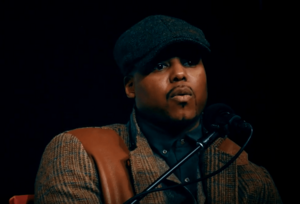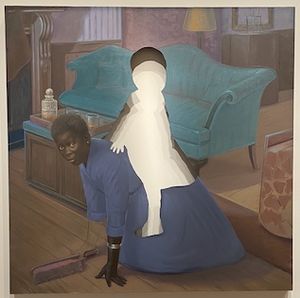Titus Kaphar facts for kids
Quick facts for kids
Titus Kaphar
|
|
|---|---|

Kaphar in 2017
|
|
| Born | 1976 (age 48–49) Kalamazoo, Michigan, U.S.
|
| Education | San José State University Yale University |
| Occupation | Artist |
| Honours | MacArthur Fellowship Recipient (2018) |
Titus Kaphar is an American artist who creates paintings and films. He is known for changing and remaking art history to include stories and people from African-American history. His artworks are displayed in many famous museums. These include the Museum of Modern Art, the Brooklyn Museum, and the Yale University Art Gallery.
Contents
About Titus Kaphar
Titus Kaphar was born in 1976 in Kalamazoo, Michigan. He first learned about art in a college art history class. He taught himself how to paint by visiting museums and studying artworks. He earned his first art degree from San José State University in 2001. Later, he received his master's degree from Yale University.
Kaphar's art often goes beyond a flat canvas. His works can be three-dimensional, like sculptures. Sometimes, parts of his paintings are cut or hang off the frame. Other times, one painting might hang over another. This unique style helps him tell deeper stories.
Early Artworks and Style
One example of Kaphar's unique style is Behind the Myth of Benevolence. This painting shows a portrait of Thomas Jefferson. Kaphar attached it to a corner of another painting. This second painting showed Sally Hemings, an enslaved woman who had children with Jefferson.
By placing these two images together, Kaphar highlights the unfair power difference between them. He uses art to show a more complete picture of history.
The Vesper Project
The Vesper Project is a special art installation created by Kaphar. It lets visitors walk through a recreated 19th-century house. The project tells the story of a fictional African-American family. This family lived in the 1800s and was "passing for white." This means they were light-skinned enough to be seen as white.
Kaphar designed the installation to make visitors wonder what was real and what was a memory. He got the idea when he tried to paint his aunt. He realized some of his memories of her were not completely true. He said his brain had added her to times when he needed support. This made him feel like he could not trust his own memories.
Inspiration for The Vesper Project
The Vesper Project also came from a surprising event. A visitor named Benjamin Vesper had a mental breakdown at the Yale Art Gallery. He damaged one of Kaphar's paintings. While Vesper was in the hospital, he and Kaphar started writing letters to each other. They wrote about their families and mental health.
Vesper later left the hospital and visited an old 19th-century house. He believed it was his family's home. Kaphar wanted to create a real place for Vesper to go back to and face his memories. This idea became the basis for The Vesper Project. The rooms in the installation contain pieces of memories and ghostly figures. Visitors can walk through these rooms and experience the story.
Art for Time Magazine
In 2014, Time magazine asked Kaphar to create a painting. This artwork was a response to the Ferguson Uprising. The uprising was a series of protests in Ferguson, Missouri. Kaphar's painting was about 4 by 5 feet in size. He used oil paints on canvas.
The painting is called Yet Another Fight for Remembrance. It shows two protesters with their hands raised. Kaphar used his signature style by painting white streaks over their bodies and faces. This technique makes the artwork even more powerful.
Behind the Myth of Benevolence (2014)
In 2014, Kaphar created another version of Behind the Myth of Benevolence. This painting shows President Thomas Jefferson and Sally Hemings. Hemings was an enslaved woman held by Jefferson. She was also the mother of six of Jefferson's children.
Kaphar painted the canvas to look like a curtain being pulled back. This reveals a seated Hemings behind a portrait of Jefferson. It is like a painting within a painting. Kaphar explained that the woman in his painting is not just Sally Hemings. She represents many Black women whose stories have been hidden by history.
This painting was displayed at the National Portrait Gallery in Washington, D.C.. It was damaged three times while on display. Because of this, the museum had to place security guards near the painting.
Exhibiting Forgiveness Film
Titus Kaphar also directed his first full-length movie. It is called Exhibiting Forgiveness. The film stars actors like André Holland and Andra Day.
The movie first showed at the Sundance Film Festival on January 20, 2024. It was released to the public on October 18, 2024.
Art Exhibitions

Kaphar has had many solo art shows in the United States and other countries. Some of his solo exhibitions include:
- The House That Crack Built (2000) at San Jose State University Gallery
- The Jerome Project (2014) at the Studio Museum in Harlem in New York
- The Vesper Project (2014), which started at the Contemporary Arts Center in Cincinnati
- Language of the Forgotten (2019) at the Massachusetts Museum of Contemporary Art
He has also been part of many group exhibitions. These include The Black Index (2021) and Afro-Atlantic Histories (2022). His work, Shadows of Liberty (2016), was shown in Currents and Constellations: Black Art in Focus (2022). This exhibition was at the Cleveland Museum of Art. Shadows of Liberty is Kaphar's new version of an old painting. It reimagines John Faed's Portrait of George Washington Taking the Salute at Trenton from 1856.
Notable Artworks in Public Collections
Many of Kaphar's important artworks are held in public museum collections. Here are a few examples:
- Uncle Thomas (2008) at the Seattle Art Museum
- Doubt (2010-2011) at The Legacy Museum/National Memorial for Peace and Justice
- The Jerome Project (Asphalt and Chalk) V (2014) at the Museum of Modern Art
- Stripes (2014) at the National Gallery of Victoria in Melbourne, Australia
- Shadows of Liberty (2016) at the Yale University Art Gallery
- From a Tropical Space (2019) at the Museum of Modern Art
- Contour of Loss (2020) at the Metropolitan Museum of Art
Awards and Recognition
Titus Kaphar has received several important awards for his art. These include:
- 2001 California Arts Council Grantee
- 2006 The Studio Museum in Harlem
- 2009 Seattle Art Museum
- 2015 Creative Capital Award
- 2018 MacArthur "Genius" Grant

